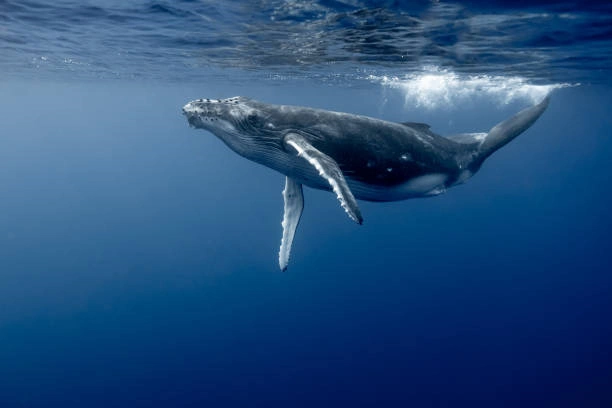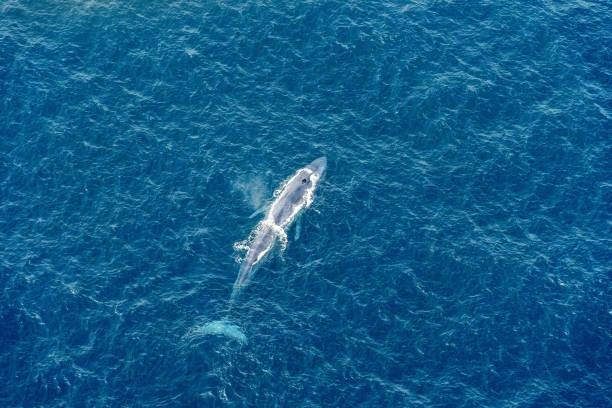The blue whale (Balaenoptera musculus), the largest animal to have ever lived on Earth, is a marvel of the natural world. These gentle giants of the ocean can reach lengths of up to 100 feet and weigh as much as 200 tons, making them the undisputed giants of the seas. Despite their size, blue whales are known for their grace and gentle nature, gliding through the oceans with a calm majesty that has fascinated scientists and nature lovers alike. In this introduction, we’ll explore the blue whale’s physical characteristics, diet, habitat, behavior, and conservation status, shedding light on what makes this extraordinary species so unique.

Contents
Blue Whale
The blue whale’s sheer size is its most defining feature. As the largest animal on Earth, blue whales can grow longer than three school buses placed end-to-end. They have long, slender bodies that are typically a mottled blue-gray color, with lighter undersides that can appear almost white. The texture and coloration of their skin are unique, with patterns that can help researchers identify individual whales. Blue whales also have a small dorsal fin located near the tail, and their broad, flat heads make up about one-quarter of their body length. Their powerful flippers are about 12 feet long, while their massive tails can span up to 25 feet across, helping them propel their immense bodies through the water with remarkable speed and agility.
Diet: Feeding on the Tiny
Despite their enormous size, blue whales feed almost exclusively on one of the smallest organisms in the ocean—krill. A blue whale can consume up to 4 tons of krill each day during feeding season. They feed by taking in vast amounts of water and krill and then using their baleen plates—comb-like structures in their mouths—to filter out the water, leaving the krill behind to be swallowed. This feeding process, known as lunge feeding, requires tremendous energy and is often performed in the colder, nutrient-rich waters of the polar regions, where krill are most abundant. During the summer months, blue whales focus on building up fat reserves, known as blubber, which will sustain them during their long migrations to warmer waters.

Habitat: A Global Traveler
Blue whales are cosmopolitan creatures, inhabiting all the world’s oceans, from the Arctic to the Antarctic. They are most commonly found in deep, open waters rather than near coastlines. Blue whales migrate across vast distances between feeding grounds in polar regions and breeding grounds in tropical or subtropical waters. These migrations can span thousands of miles, making blue whale some of the most far-ranging mammals on the planet. While they are generally solitary animals, blue whale may be seen traveling in small groups or pairs, particularly mothers and calves. Despite their global presence, certain populations are more concentrated, such as those found in the North Atlantic, North Pacific, and the Southern Ocean.
Behavior: Gentle Giants of the Deep
Blue whales are known for their calm, gentle behavior. They are slow swimmers, typically moving at speeds of about 5 miles per hour, but they can accelerate up to 20 miles per hour when threatened. Blue whale communicate with each other using low-frequency vocalizations that can travel over vast distances in the ocean, possibly hundreds of miles. These sounds, which include moans, pulses, and clicks, are among the loudest sounds produced by any animal and are believed to play a crucial role in social interactions, navigation, and locating prey. Blue whale are generally solitary, but they are sometimes found in small groups, particularly during feeding times when food is plentiful.

Reproduction: Nurturing the Next Generation
Blue whales reach sexual maturity at around 5 to 10 years of age. Breeding typically occurs in warmer waters during the winter months, and after a gestation period of 10 to 12 months, a single calf is born. At birth, a blue whale calf is already one of the largest animals on the planet, measuring around 20 feet in length and weighing up to 3 tons. The calf will nurse for about six to seven months, consuming up to 100 gallons of its mother’s milk each day, which is rich in fat to support its rapid growth. During this period, the calf can gain as much as 200 pounds per day. The strong bond between mother and calf is essential for the calf’s survival, especially in the early stages of life.
Conservation Status: Challenges and Efforts
Despite their size and strength, blue whale were nearly driven to extinction by commercial whaling in the 20th century. By the mid-1960s, their numbers had dwindled to less than 5% of their original population, prompting a global ban on hunting blue whale in 1966. Today, the blue whale is listed as endangered on the IUCN Red List, with an estimated global population of around 10,000 to 25,000 individuals. However, they still face significant threats from ship strikes, entanglement in fishing gear, noise pollution, and the impacts of climate change on their food supply. Conservation efforts focus on monitoring populations, protecting critical habitats, reducing ship strikes, and raising public awareness about the importance of protecting these majestic creatures.
The Blue Whale: A Symbol of Ocean Grandeur
The blue whale stands as a symbol of the ocean’s grandeur and the delicate balance of marine ecosystems. As the largest animal on Earth, it is a reminder of the planet’s incredible biodiversity and the wonders of the natural world. Despite their massive size and power, blue whales are vulnerable to human activities and environmental changes. Protecting these magnificent creatures is not just about saving a species but also about preserving the health of our oceans and the countless life forms they sustain. Understanding the blue whale’s life, behavior, and challenges is essential to fostering a sense of stewardship and ensuring that future generations can marvel at this remarkable giant of the sea.


